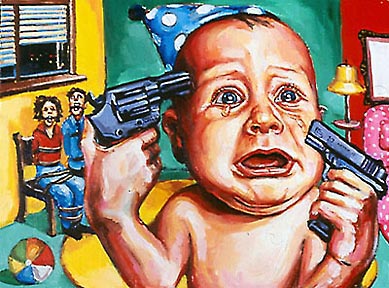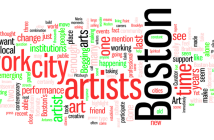I was suspicious when I walked into the opening, the gallery turned into a discotèque, bass pumping, dimmed lighting, a video projection—presumably of Caleb Weintraub’s—projected on a wall.
Galerie Swanström is a newbie in the 450 Harrison fine-arts ghetto-complex, offering not only contemporary fine art, but an arts consulting business. Perhaps this sheds some light on the use of “s’il vous plait” on their oversized business cards, but I thought it was a faux pas to use French language as a marketing tool, particulièrement dans le monde de la galerie, non? I’m unfamiliar with the music that scored my experience there, but I don’t believe it was of German decent. Why not spice up our evening with something from Central Europe to go along with the gallery’s name? They might benefit from a trip to the new bar which goes by the name of the county which it resides on Thursday nights; they‘d come across some contemporary German disco (e.g. Robag Wruhme) complements of the man on the one’s and two’s, Eric Pierson. I suggest this for the next opening.
The music and lighting may have been present to underscore the work of Caleb Weintraub, a recent graduate of BU and UPenn MFA as his “work is about over stimulation and desensitization” as electronic music is often employed to illustrate in films and television. His paintings are about much more than desensitization, however, they may demonstrate it more than anything else. I fear that this work will be lost in the rather vast amount of work that seeks to comment on “the disintegration of moral and spiritual awareness and the absence of accountability in our culture,” yet actually only ends up participating within the same culture.
The paintings themselves are a cartoon-ish hell: babies and young children with oversized eyes point hand-guns into their faces and stand pregnant with tearful looks on their round cherubic faces, a cherub army massacres a city square. They are painted in a style that emulates the old European masters such as Poussin who Weintraub seems to reference not only in style but with cherubs throwing bombs and shooting guns instead of tossing apples from an apple tree. The cartoon-ish quality of the works comes from its simplifications, simplifications in the same way that Poussin simplified his subjects—wrinkles, blemishes removed, the features most useful for portraying beauty left intact and often embellished. Cartoons simplify and exaggerate for purposes of humor or identification of or with. The children’s eyes enlarged as has become the common style in American cartoons (after Japanese), from Disney films to South Park.—it was indeed South Park that introduced the nation to the hilarity of cursing children paralleling Weintraub’s work with its themes of desensitization.
The choice of children to articulate his themes is a reference to the old masters with their cherubs and children signifying innocence, but in his work, their presence is purely ironic. The use of children may also be more about pedophobia as there is a long standing and extremely successful tradition of pedophobic horror films, which Weintraub may very well be aware of, unless he himself is indeed afraid of children. The painting style is indeed ironic as well, evoking a pathos that works against the subject of the work. Irony, or sarcasm, as may be the central theme here, is a prevalent phenomenon in our society today as it undoubtedly informs Weintraub’s work.
There are undoubtedly countless other ways to demonstrate over stimulation and desensitization both in an artists choice of subject matter and medium. Why work in painting? Painting as a medium holds only a fleck of the cultural relevance as it did when his heroes graced the courts of the Renaissance and Enlightenment, it is now considered to be a decadent commodity and gesture. One may argue that, without our history of painting, the imagery of our present culture (e.g. mass media) would have not be comparable to what it is today, but that still leaves his work in a relatively esoteric niche.
Painting is thought to have the ability to create the most potent images, whether ideologically or emotionally, painting enables the artist to pull the strings of the viewers’ emotions more effectively than any other visual medium, except cinema, but try to image an entire film as silky and luminously gorgeous as a Vermeer. Weintraub believes that the works of the old masters lacked truth, however. He posits that it can only be attained through the extreme; but artwork that aspires for the extreme fuels the same culture that he wishes to deconstruct.
Weintraub also works in video and may find that working with such a medium may function more effectively at achieving the specific excess and extremes his work is about. Mass media is the main proponent of “culture that has lost its ability to be scandalized” as he seems to imply in his statement. It is perhaps even the reason it apparently became that way.
Links:
Galerie Swanström
"Caleb Weintraub: See How They Run" is on view until January 29th at Galerie Swanström, at 450 Harrison Ave., Boston.
All images are courtesy of the artist and Galerie Swanström.
Christian Holland has been writing for Big, Red and Shiny since its inception, occasionally making movies, herding cats, and dabbling in political consulting.



